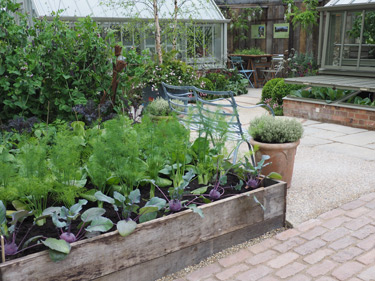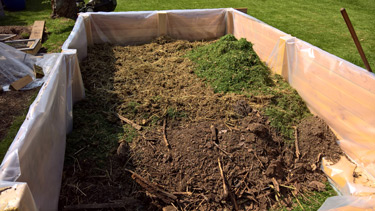Above ground
Lifting a garden above ground level provides many benefits. From the plant’s point of view, there is improved drainage and soil that warms up faster in spring. For the gardener, raised beds offer a more comfortable experience when planting, weeding and harvesting.
For older or disabled people, raised beds may be the difference between gardening and not gardening. Well- designed raised beds are easy to cover, providing protection from weather extremes and pests. Crop rotation is simplified when there is room for a series of narrow beds.
On the downside, improved drainage may become a problem when the weather is hot and dry, increasing watering demands although this can be alleviated via mulching, moisture retentive soil mix and well-designed irrigation. Raised vege beds hold more soil and hence need less watering than pots. Some excellent raised garden systems are available for gardeners needing a more portable option.
Raised beds …
- improve soil drainage - good for plants.
- warm up faster in spring - good for plants.
- reduce or eliminate bending - good for gardeners.
- are easy to manage - good for gardeners.
- mean we can match the soil to the plants we want to grow.
Form and function
When building raised beds the biggest decisions revolve around cost, durability and attractiveness of the building materials. Plants will grow happily in any vessel as long as they have good soil and drainage. Beds may be built from repurposed objects such as old furniture or temporary surrounds such as bales of straw. A raised garden can be as simple as a mound of soil. For built garden beds the options extend to timber, masonry and metal.
Timber is the most popular choice. It is a versatile building material and the likes of growing frames and crop covers can be easily attached. Ground treated timber is the most durable.
Modern wood treatments do not involve harmful heavy metals, but to prevent wood preservative leaching into the soil some gardeners use black plastic liners.
Alternatively, untreated rot- resistant hardwood timber is also very long lasting, but more expensive. Old railway sleepers are a very attractive option although costly and very heavy.
Beds built from brick, stone or concrete are strong and durable but can also be costly. Skilled labour is often required, but many an old patio or garden path has been repurposed into garden bed edges. Bricks allow for lovely curves and circular beds. Masonry walls higher than 20cm tall should be bonded with mortar and laid on concrete footings. Those built on top of hard surfaces need to be correctly designed to allow for proper drainage.
Metal bed edging is easy to form into shapes and provides extra warmth for heat loving plants. Recycled plastic ‘timber’ lookalike garden edging can be effective when it comes to preserving moisture, but these products should be UV stabilised for durability in New Zealand’s bright sunlight.
Fit for purpose
Pick the perfect spot. Sun is essential for vegetable crops and level ground will make installation easy. On sloped ground, terracing and retaining walls can enhance accessibility and drainage. Running longer beds from north to south allows more even distribution of sunlight than those running east to west. However, a shady side can be an advantage for the likes of summer lettuce crops.
Bed width should be no greater than 1.5m for easy access from each side without stepping on the soil. Try not to have too many long runs of beds or you’ll be tempted to step on the soil to get to the other side. Ideally, at least 45cm should be allowed for pathways between beds, which is wide enough for a wheel a wheelbarrow.
The ideal bed height varies according to the gardener and what they wish to grow. A depth of 30cm is plenty for most vege crops if beds are built on good average garden soil. For beds sitting on hard surfaces (including compact heavy soil) allow a minimum depth of 45cm. Taller beds make for excellent access and ease of management.
Watering systems deserve careful planning. Hand watering can be time-consuming, but is very effective and efficient. Many gardeners enjoy watering time as a time to check on their plants and relax. For hassle- free watering invest in a watering wand attached to a kink-free hose. Soaker hoses and drip irrigation systems are great for gardeners pressed for time and can be set up to run on a timer.
Soil matters most
Regardless of what we build them from, what we fill our garden beds with makes the most difference to healthy plant growth.
Topsoil is ideal if you have a ready supply of the real deal. By topsoil we mean the uppermost layer of living soil, high in nutrients and organic matter. Generally, the darker its colour, the greater its humus content and the better it is for your plants. To save cost, fill garden beds with any topsoil scooped from paths and bury any turf removed in the lower levels.
Alternatively, when your garden soil is poor or non existent, topsoil or manufactured growing media is available for purchase either in bags or by the trailer load. Premium mixes should be free of weed seeds and soil borne pests and diseases.
Compost is nature’s number one soil improver. Use it to bulk up your topsoil and top up raised beds as required. Vegetable plants will thrive in pure compost as long as it
is properly decomposed. Be wary of compost that hasn’t yet completed the composting process. A little bit of heat can be a good thing, especially in early spring, but compost that is too raw can burn plants and rob them of nutrients.
The No Dig Garden
Growing vegetables in raised beds provides the perfect opportunity for a ‘no-dig’ garden. Though great for people whose idea of exercise isn’t digging, the real rationale for a no-dig garden is healthier soil and the fact that good soil is a living breathing ecosystem full of microorganisms thriving in harmony with plants. Overworked soil becomes lifeless, structureless and prone to compaction.
There are various ways to build and maintain a no-dig garden. All involve layers of organic matter, often referred to as the ‘lasagne’ garden.
In its simplest form it is a thick layer of compost on top of bare soil with a layer of straw on top. Plants thrive on the moisture and nutrients in the compost layer while the straw layer preserves moisture and provides insulation, eventually breaking down to become another layer of compost where soil microorganisms thrive and prosper.
How to make a no dig garden
Start with a thick layer of cardboard or newspaper to block perennial weeds.
Add a layer of straw to form a loose airy layer that will assist drainage.
Add a layer of best quality homemade or purchased compost mixed with well rotted animal manure. Then another layer of straw.
Repeat as necessary until your bed is full.
Make pockets of compost in the top layer of straw to plant your seedlings into. Alternatively, (especially in hot dry weather), part the top layer of straw mulch and plant into a thick compost layer below. It’s that simple!
As time goes by the straw breaks down and the no dig garden is built up with more layers of straw and compost. So there’s no need to dig but plenty or scope for healthy exercise, albeit with wheelbarrow and garden fork instead of a spade.
TIPS:
- When sowing large seeds such as sweetcorn or zucchini, sow two seeds at each station, removing the weakest after germination.
- Herbs and flowers planted for extra colour will also attract beneficial insects and help repel pests.
- Mulching is the best way to keep moisture in the soil. A good layer of organic mulch will also save hours of weeding and enrich the soil as it rots down. As you trim herbs and shrubs, lay the prunings on the ground as mulch.
- Pea straw placed around fruiting plants like cucumbers, strawberries, eggplants, and dwarf tomatoes keeps the fruit clean and dry.
- Tomatoes and other fruiting plants need regular watering especially once the fruit appears. Avoid watering in the middle of a hot day when evaporation is fast. If possible, water in the morning before the sun gets up.
- Veges grown in containers need regular feeding.

4-Nov-2019

Raised beds for vegetables


Building up a no-dig raised garden.

